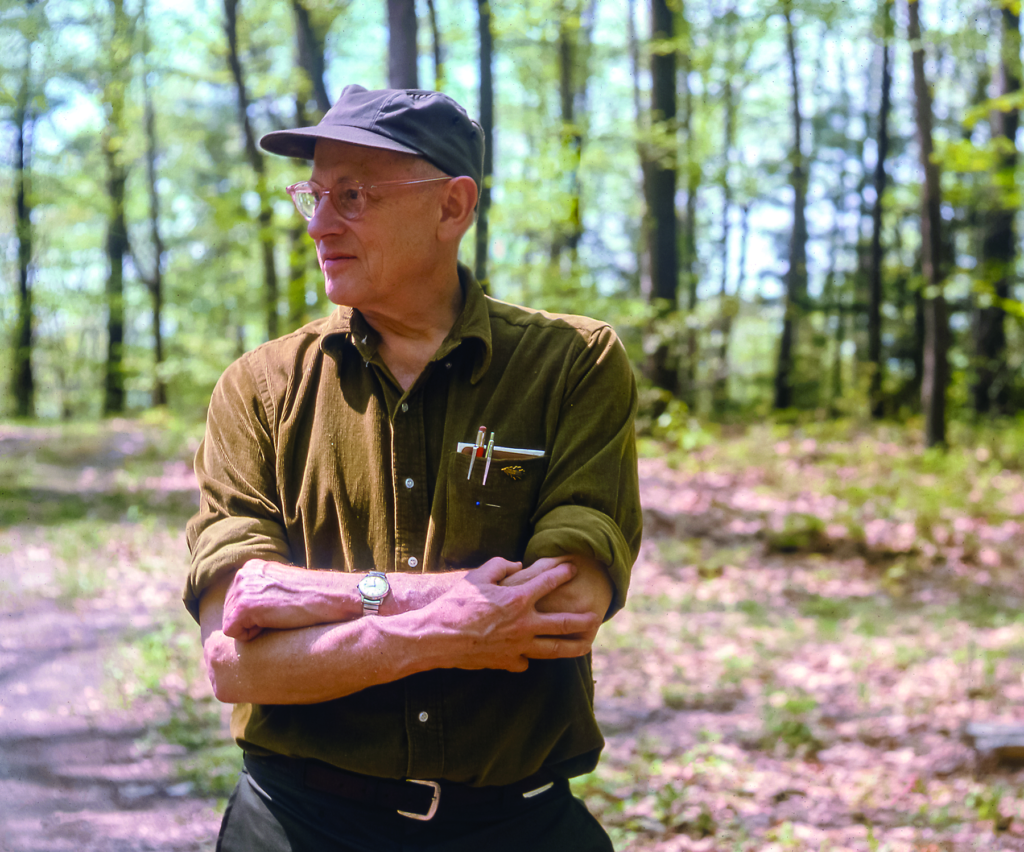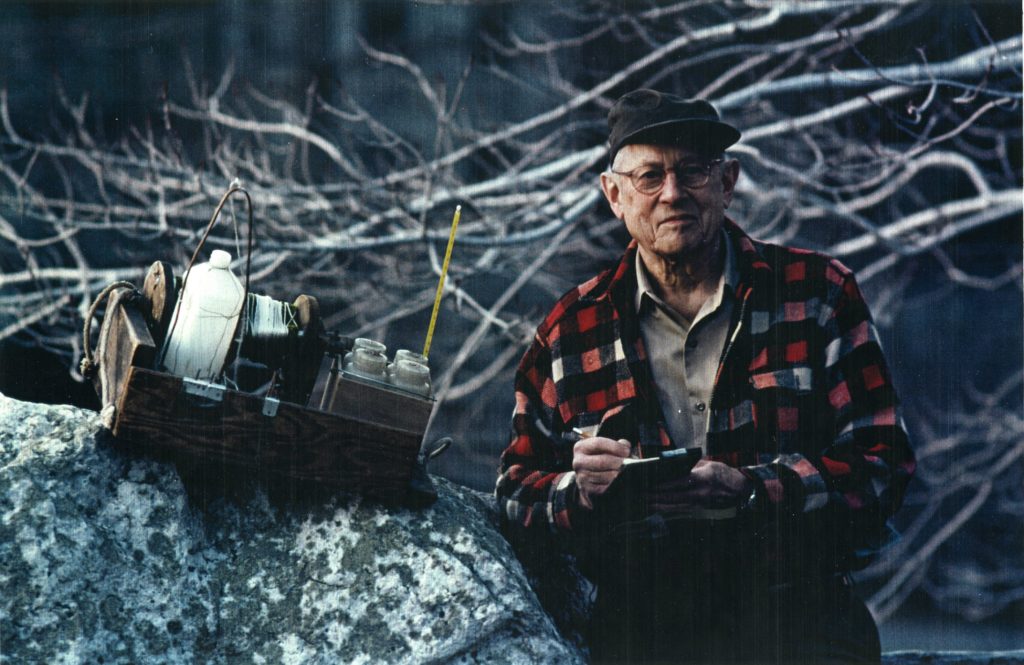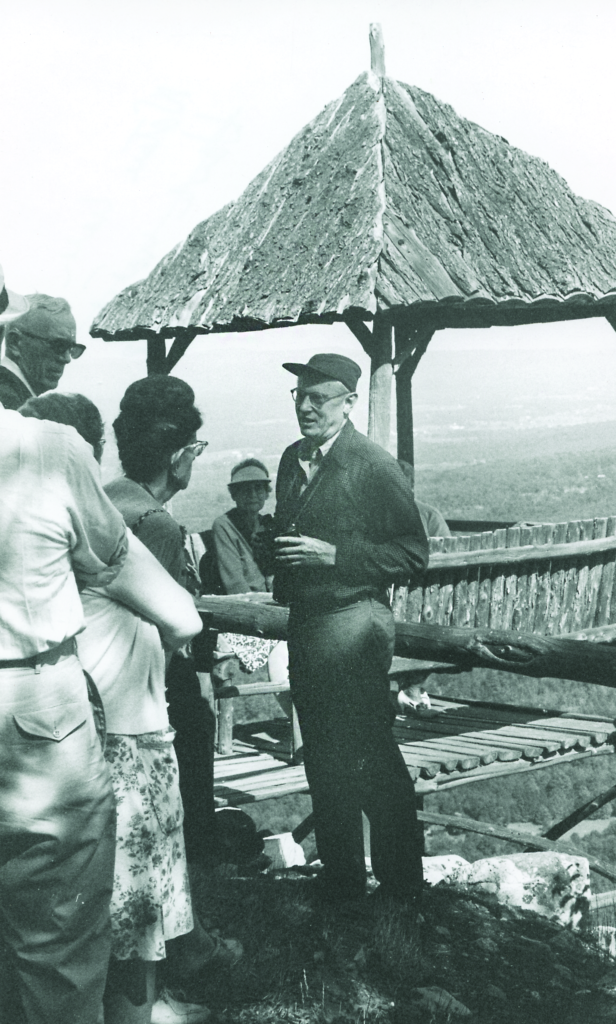Stories from the archives: Daniel Smiley of Mohonk, Ecosystem Ecologist
July 22, 2020By Jewel Alston, Cornell class of 2021
A memoir inspired by Nest Quest Go!
Hidden in stacks of yellowed index cards at the Cornell Lab of Ornithology are rich stories of early citizen scientists. The Cornell Lab’s North American Nest Record Card Program ran from the 1960s to the early 2000s and amassed more than 300,000 records on bird nests. To make these data more accessible to researchers, NestWatch developed the Nest Quest Go! project to focus on transcribing and digitizing these cards. This is the story of Daniel Smiley’s contributions to our historic Nest Record Card collection.

Dan Smiley at Mohonk Preserve, 1975.
An Idyllic Early Life
Nestled in New York’s Hudson Valley lies the Mohonk Mountain House, a Victorian-style castle resort surrounded by an 8,000-acre preserve. This is where the Daniel Smiley Research Center is located—and where Dan Smiley was raised. Although he was born into the luxury resort industry, Dan preferred to be outside. From a young age, Dan became what many of us would call a naturalist, using each precious minute of daylight to learn something new about Mohonk. The wildlife never ceased to amaze Dan, from the birds swooping above his head to the critters burrowing beneath his feet. Every connection, both visible and invisible, inspired another question in Dan’s mind.
Motivated by curiosity, Dan spent his days adventuring throughout the preserve. While it was common for children to spend a lot of time outside, Dan’s connection with Mohonk was deep and lifelong. When he was about 10 years old, Dan wrote a short story about his ideal forest, in which he wished, “The trees and flowers would be about the same as around here. The only thing that I would add to the animal life would be fishers and martens.” By carefully observing the forest, Dan developed a keen sense of his surroundings. If a small patch of wild blue indigo (Baptisia australis) popped up, he would notice.

Dan Smiley Recording Observations, 1984.
Dan the “Ecosystem Ecologist”
After encountering something noteworthy, Dan would carefully document it on a 3 × 5″ index card. At dusk, after tucking away a day’s worth of cards, Dan would return home to put them into an index card organizer. Throughout his life, Dan recorded observations on more than 14,000 cards. As a part of his fascination with birds, Dan submitted nest-record cards to the Cornell Lab of Ornithology. Dan knew the value of data and saw the importance of sharing his findings. All of his personal index cards are currently being transcribed on Zooniverse, while the nest records are hosted by the Nest Quest Go! project.
Keeping records helped Dan preserve his observations, but more than that, it helped him identify patterns revealed by them. One problematic pattern that Dan noticed was the sudden increase in gypsy moths in the late 1950s. Dan, however, successfully fought to prevent federal authorities from spraying DDT on the Mohonk preserve to combat the gypsy moth invasion. In his eyes, spraying insecticides would put the ecosystem and its natural balance at risk—the ecosystem he’d spent his life studying. Discovering a new connection or interaction within the ecosystem fueled Dan, making him want to share his passion with the world.

Dan Smiley Leading a Nature Walk, 1968.
A Legacy Of Inquiry
Guiding nature walks for the guests at Mohonk satisfied Dan’s need to stay involved in the business without depleting his time spent in nature. At all points along the 75 miles of hiking trails, he helped his guests find inspiration by looking more closely at their surroundings. Dan wanted to spark curiosity in others and inspire them to engage with the natural world. He hoped that fostering their curiosity would encourage his guests to learn more about, and find connections to, their own natural spaces.
At home, Dan involved his children in his studies. Growing up, his daughter Pril recalls finding snakes in the refrigerator, her dad skinning animals at his desk, and mist nets for banding birds set up in the front yard. Dan taught his kids anything he knew as long as they were curious enough to ask.
In the spirit of inquiry, Dan couldn’t be bothered with complaints of boredom. If his children complained they had nothing to do, he’d suggest, “Take a walk,” or “Get on your bicycle,” and if they persisted with claims of boredom, he’d respond, “I guess you’re gonna have to get curious about something or interested enough in something to find something to do, aren’t you?”
Asking the right questions seemed to be Daniel Smiley’s key to life. Asking questions that lead to new questions can be helpful in all aspects of life. Being curious allows us to better understand ourselves, each other, and the world in which we live. Dan Smiley, a lifelong learner and quintessential citizen scientist, knew the value of an inquiring mind. His motto in life could be summed up as: it doesn’t matter so much what you learned today, but rather that you asked a good question.

6 comments on “Stories from the archives: Daniel Smiley of Mohonk, Ecosystem Ecologist”
The article was wonderful. My only wish is that I never had an opportunity to meet him face to face. He sounds like an extraordinary man that was way ahead of his time. Thank you again.
Thanks, Sharon. I feel the same way. A week or two ago, I took a trip down to Mohonk to hike around the preserve to feel a little closer to the story!
What an inspiring story about a kindred spirit!
Chrisula, thanks!
Yes, great story! That’s a great idea Jewel – I think I’ll put this place on my bucket list. Thanks for the inspiration. 🙂
I was very fortunate to grow up at Mohonk. I was even more fortunate to live next door to San Smiley. He was a fascinating man who always waved to us kids and always had a kind word. Sometimes I would find a dead bird in the woods and it would have an identification band on its leg. Regardless it it had a band or not I would always bring it to “Mr. Dan”. He was always thankful when I did that. I also remember that Dan would go up to the lake every day and draw water samples and temperatures from various depths. Just a wonderful and fascinating man that I had the pleasure of knowing while growing up in this special and beautiful place.